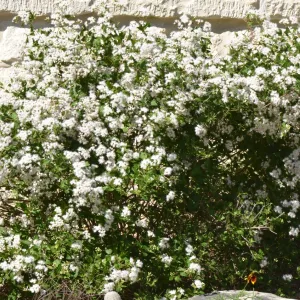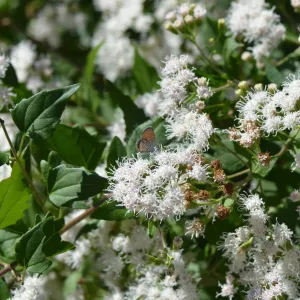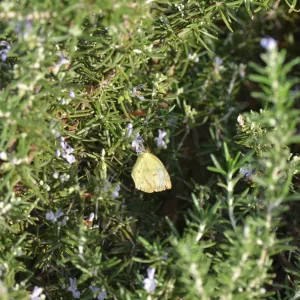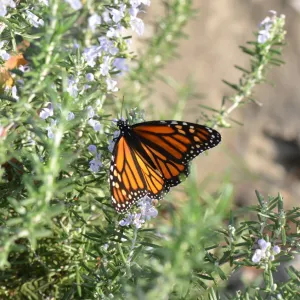By Delmar Cain
by Delmar Cain – Boerne Chapter, Native Plant Society of Texas
Published in the Boerne Star on December 6, 2013
The recent freeze that installed the new carpet of fallen leaves indicates that the blooming season for most plants is over. For many plants the fruit season has arrived. The rich red fruits of small trees like possumhaw, yaupon, and evergreen sumac and of other plants like Carolina snailseed and pigeonberry remind me of one reason that the color “red” figures so prominently our holiday festivities and costumes.
Fruit usually means “easy pickings” for the birds and small mammals. I say usually because over a week-period I had to release a northern cardinal and two mockingbirds captured in the chicken-wire deer cover around the pigeonberry plant in our yard. Each had tunneled under the cover to eat the berries, but tried to fly to escape.
Luckily I had passed the test to obtain my certificate from TPWD for tagging whitewing doves. It included instructions on how to release inadvertently captured songbirds. Consequently on each capture, when I lifted the cover, the incarcerated bird escaped quickly and safely. None returned with a thank you note for the berries eaten or the escape-assist.
But, unless fruit has escaped hungry mouths and is decaying, it generally is of little use to butterflies. Butterflies are more likely to be drawn to nectar producing flowers. Those that are still blooming this time of the year may draw quite a crowd, fulfilling the role of the only lunch in town.

In different reports from the time period of November 16-19th, two avid butterfly watchers found large numbers of butterfly species nectaring on a few late blooming plants. Tom Collins lives on a ranch near Center Point, Texas. On the 16th Tom counted 34 different species of butterflies and 5 species of moths feeding primarily on the blooming thoroughwort (Ageratina havanensis) with a few on the fading blue mistflower.

In only an hour and a half on November 19, Patty Leslie Pasztor and a group of naturalists saw 29 species of butterflies on two shrubby boneset plants (another common name for Ageratina havanensis) on a ranch in northwest Kendall County. Again in both of these sightings, the reporters were counting species. The individuals in each species were sometimes in the teens and in one instance triple digits.
Shrubby boneset was the NICE (Native Instead of Common Exotics) Plant of the Month, selected by the Boerne Chapter of the Native Plant Society of Texas (NPSOT) for September 2011. The Native Grown Article for September 9, 2011, which can be found under Publications on the Boerne Chapter website, provides details on purchasing and planting this wonderful Hill Country native.
If you are developing a butterfly garden, shrubby boneset is a plant that should not be omitted. The San Antonio Botanical Garden uses it liberally in its native landscaping. Its normal bloom period is October and November, but I have seen it bloom in the summer and even into late December. It is not denuded by a good frost and will continue blooming.
Patty Leslie Pasztor noted in her report that the two shrubby boneset plants were protected from the deer by growing in and among agarita. That fact may give you some ideas if you have a deer problem. Agarita will protect other plants and vines as well.
The other plant mentioned in Tom Collins’s report is familiar to most gardeners. Blue mistflower (Conoclinium coelestinum) is another must-have plant for any butterfly garden. In a recent article I included a photograph of this plant at the Boerne Convention Center that was covered with queen and monarch butterflies.

If you will not tell any of my NPSOT friends, I will also mention another plant that is a magnet for butterflies, bees and moths. The reason that you must not tell is because it is not a true native plant. (Some of my friends are strict constructionists about native plants.) Even though rosemary (Rosmarinus officinalis) originally came from the Middle East, it has been in the United States long enough to grow natively in Puerto Rico and in five states, one of which is Texas. It is still listed as introduced.
I have the trailing variety in my yard and appreciate that it is deer resistant, drought tolerant and does not spread rapidly. When it blooms, which it does at least twice during the year, it becomes a hummer with its attraction to the bees. It also attracts several species of butterflies and moths.

This article has turned into one with an emphasis on butterflies after I read the disturbing news of the failure of many monarchs to make it to Mexico this year at the usual time. For more information see “The Year The Monarch Didn’t Appear” by Jim Robbins in the New York Times on November 24, 2013. I hope that the final verdict will not be so dim and that perhaps the warmer weather temporarily affected the timely urge for the monarchs to go south. In any event I am growing all of the above plants and doing my part to create a friendly environment for every butterfly species that I can.
